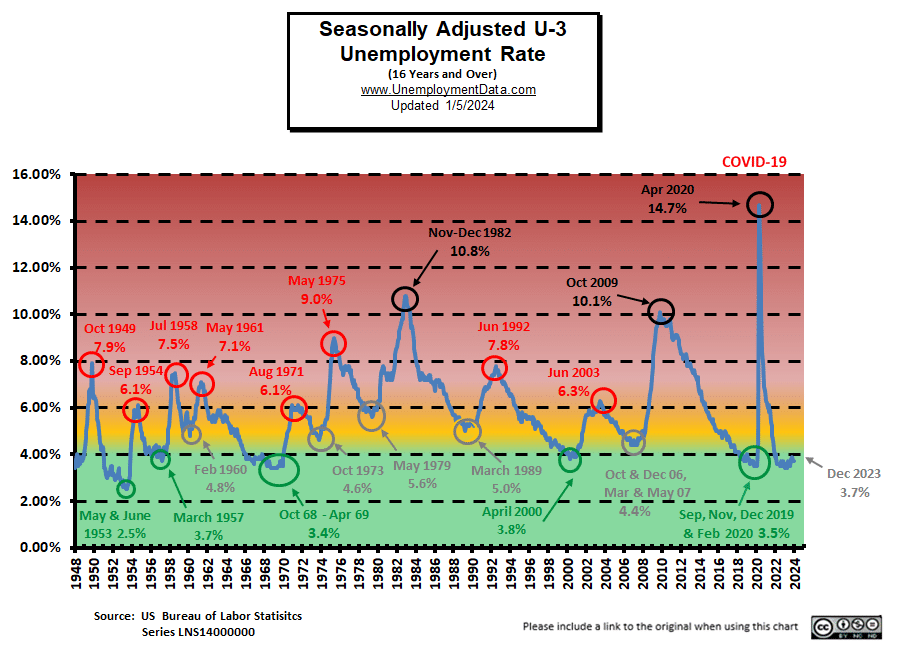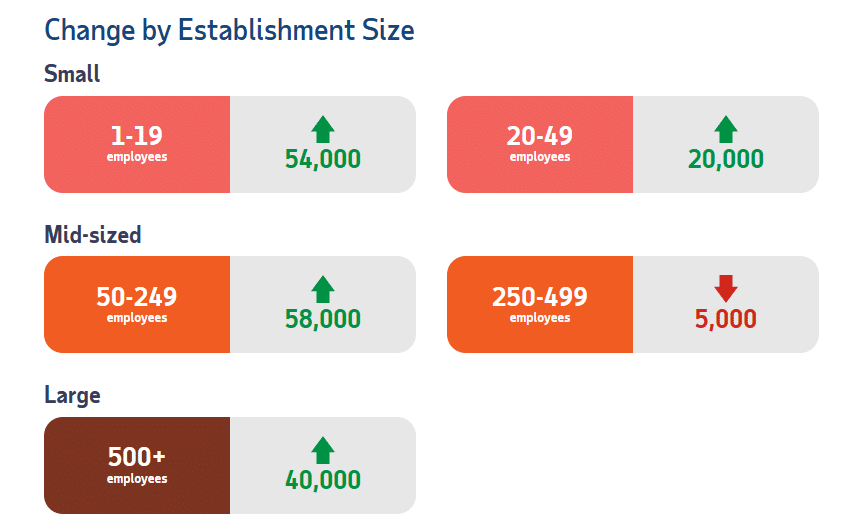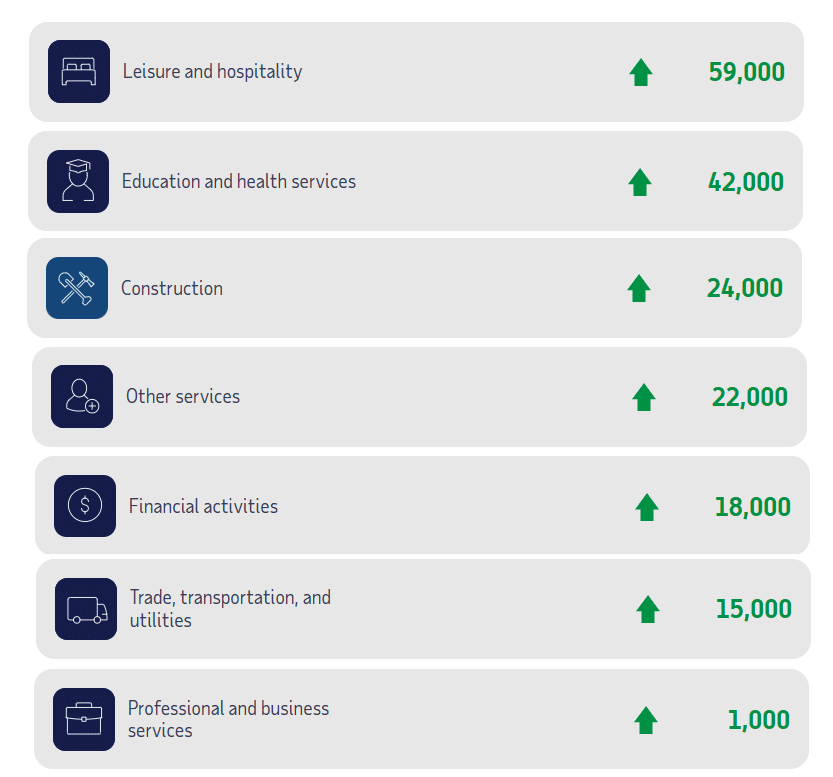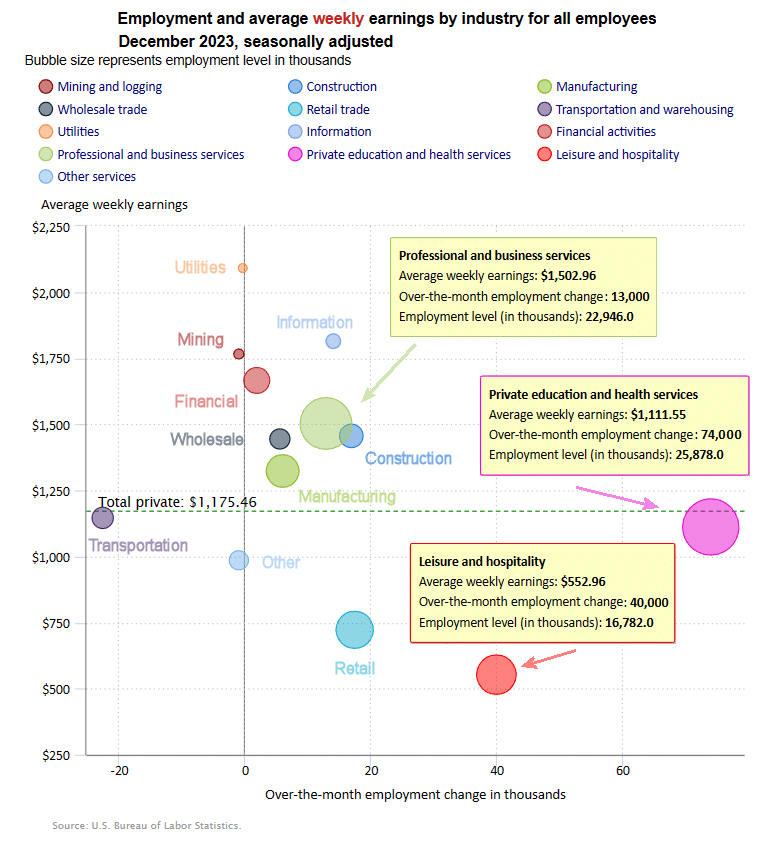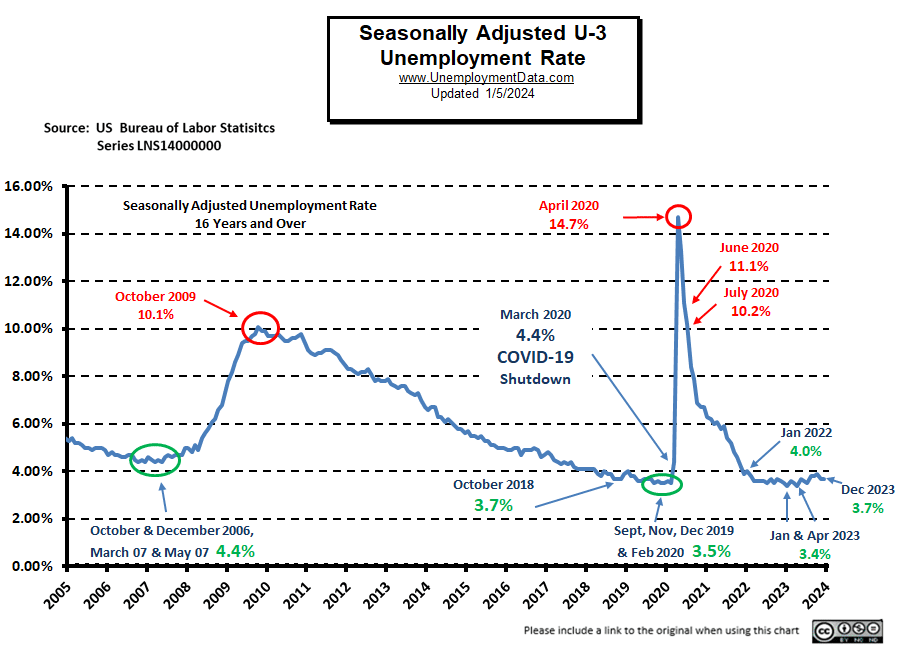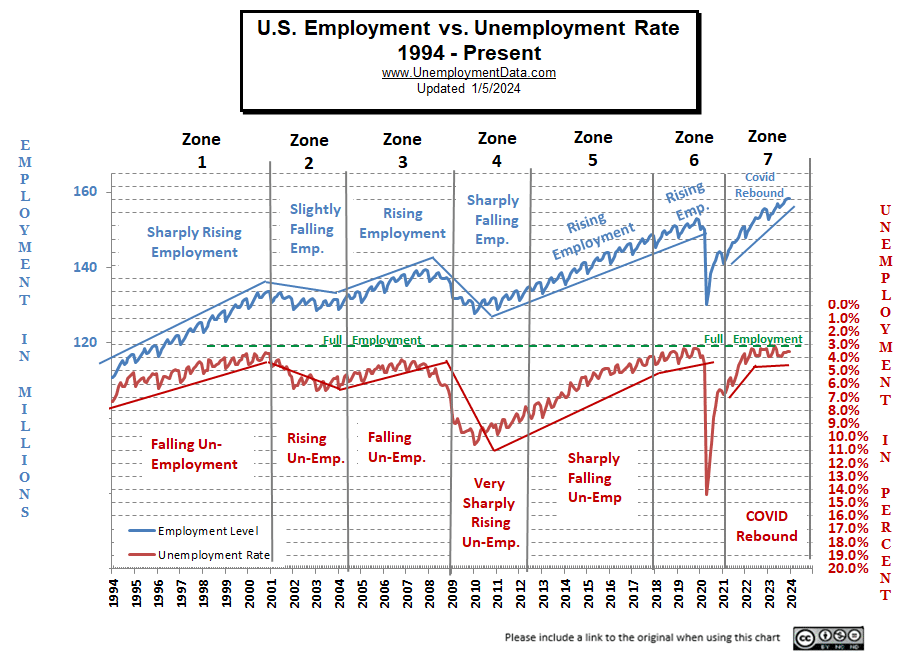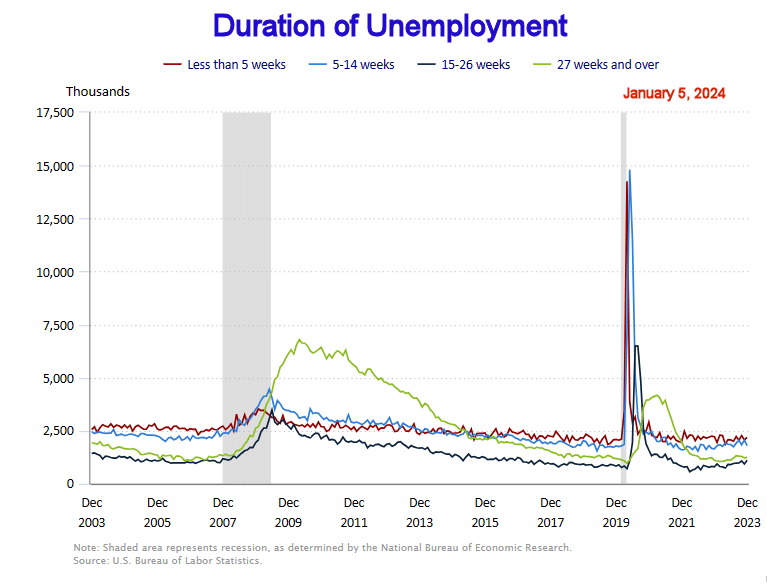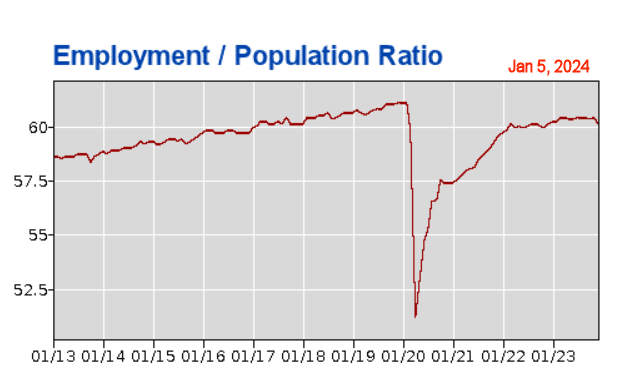The U.S. Bureau of Labor Statistics (BLS) released its employment / unemployment report for December on January 5th, 2024.
Employment Up- Unemployment Down
- Adjusted U-3 was 3.7% unchanged from November
- Unadjusted U-3 was 3.5% unchanged from November
- Unadjusted U-6 was 7.0% Up from 6.7% in November
- Labor Force Participation was 62.5% down from 62.8% in November
- Unadjusted Employment fell from 158.395 million to 158.228 million
Summary:
Total Employed decreased in December, Labor Force Participation was down but Unemployment was unchanged.
According to the Commissioner of the U.S. Bureau of Labor Statistics:
Total nonfarm payroll employment increased by 216,000 in December, and the unemployment rate was unchanged at 3.7 percent, the U.S. Bureau of Labor Statistics reported today. Employment continued to trend up in government, health care, social assistance, and construction, while transportation and warehousing lost jobs…
The unemployment rate held at 3.7 percent in December, and the number of unemployed persons was essentially unchanged at 6.3 million. These measures are higher than a year earlier, when the jobless rate was 3.5 percent and the number of unemployed persons was 5.7 million.
You can read the full BLS report here.
As usual, they are talking about “Seasonally Adjusted Jobs”.
Looking at the Unadjusted Establishment Survey report we see…Originally the BLS reported employment of 158.461 million for November which they adjusted to 158.395 million in December (for a loss of -66,000 jobs). They are currently reporting 158.228 million jobs for December which is actually a loss of -233,000 jobs compared to their original numbers. This in confirmed by the decline in the LFPR which fell from 62.8% to 62.5%.
BLS Source
Current Unemployment Rate Chart
Adjusted Unemployment is slightly above the pre-COVID 2019 cyclical lows of 3.5% as well as above the lows made earlier this year. Current levels are still within the “Green Zone”.
Current Employment Rate
Employment 2.884 million Above Year-Ago Levels
and 7.261 million above February 2020 (prior to the Covid Crash)
The Civilian Population has increased by about 8.363 million since February 2020.
Although down for the month, at 158.228 million, December 2023 Employment is still above the November 2022 peak employment level of 155.642 million.
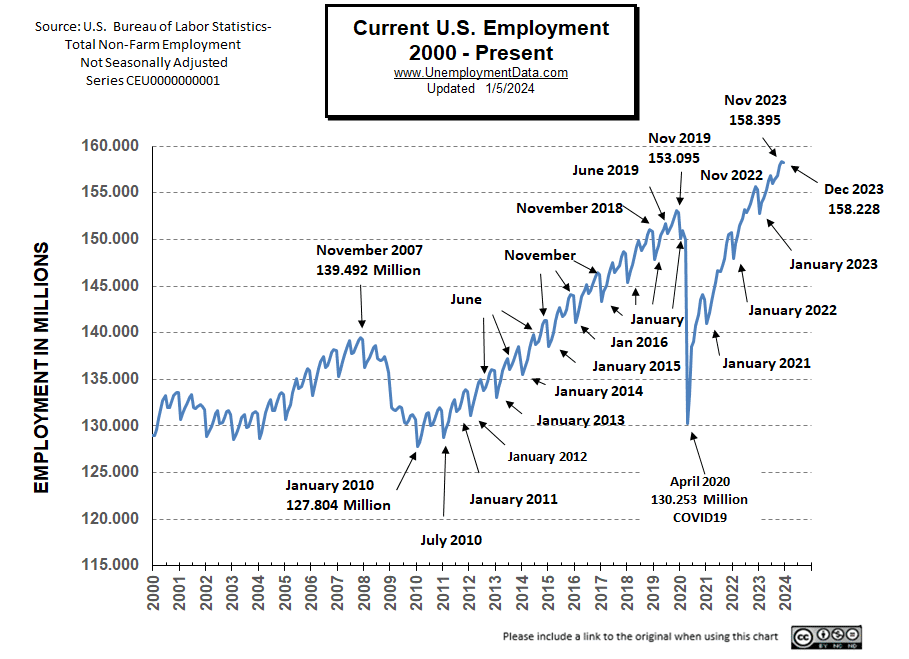
ADP® National Employment Report
ADP provides an independent (non-government) estimate of private-sector employment and pay, based on data derived from ADP client payrolls. According to ADP®, In collaboration with Stanford Digital Economy Lab.
ADP: Private employers added 164,000 jobs in December
- Job gains rose for the fourth straight month, led by a healthy bump in leisure and hospitality hiring. Construction held strong in the face of high interest rates, but manufacturing continued to struggle, notching another month of losses.
Source: ADP® Pay Insights
ADP Private Employment by Firm Size
ADP also lists increases by “firm size”.
December ADP Changes:
ADP Job Gainers
According to ADP, mostly service sectors gained employees in December.
 ADP Job Losers
ADP Job Losers
But the Manufacturing, Mining and Information sectors lost employees.
BLS: December 2023 Employment by Sector
The BLS employment “bubble chart” gives us a slightly different picture than the ADP does. The Bubble’s Size tells us the total Employment for that industry (i.e., larger bubbles mean more people are employed in that sector).
The bubble’s location on the chart tells us that there has been a change in Employment Levels over the most recent month… A bubble further to the right indicates larger job growth. A bubble’s vertical location on the chart shows the average industry salary.
Remember, these are Seasonally Adjusted Numbers, so they aren’t cumulative!
According to the BLS Leisure and Hospitality added 40,000 jobs. While Education and Health added 74,000 jobs. However, we need to remember that these are “seasonally adjusted jobs”.
BLS Average Weekly Wages
| Date | Average Weekly Wage |
| December 2023 | $1,175.46 |
| November 2023 | $1,173.04 |
| October 2023 | $1,166.20 |
| September 2023 | $1,165.47 |
| August 2023 | $1,163.41 |
| July 2023 | $1,157.28 |
| June 2023 | $1,155.15 |
| May 2023 | $1,146.99 |
| April 2023 | $1,147.58 |
| March 2023 | $1,141.34 |
| February 2023 | $1,141.61 |
| January 2023 | $1,146.14 |
| December 2022 | $1,125.73 |
| November 2022 | $1,129.01 |
| October 2022 | $1,124.01 |
| September 2022 | $1,119.87 |
| August 2022 | $1,116.42 |
| July 2022 | $1,116.54 |
| June 2022 | $1,106.76 |
| May 2022 | $1,105.47 |
| April 2022 | $1,102.01 |
| December 2021 | $1,086.46 |
BLS Employment and Average Weekly Earnings by Industry
December 2023, Seasonally Adjusted Employment
We’ve added a column to the table below showing the employment levels the BLS reported the previous month. Note that due to “seasonal adjusting,” although they may claim that there was a “monthly increase” (or decrease), there isn’t always an actual increase; you can’t just subtract last month’s “employment level” from this month’s level. For instance, Mining & Logging employment was supposed to have decreased by -1,000 in December but November had 644,000 and December had 641,000 which looks more like a -3,000.
| Industry | Dec. Monthly Increase | Dec. Ave. Weekly Earnings | Nov. Employment Level | Dec. Employment Level |
| Total Private Employment | 164,000 | $1,175.46 | 134,120,000 | 134,229,000 |
| Mining and Logging | -1,000 | $1,765.86 | 644,000 | 641,000 |
| Construction | 17,000 | $1,456.08 | 8,033,000 | 8,056,000 |
| Manufacturing | 6,000 | $1,323.35 | 12,985,000 | 12,986,000 |
| Wholesale trade | 5,500 | $1,444.36 | 6,100,400 | 6,099,000 |
| Retail trade | 17,400 | $722.60 | 15,490,700 | 15,543,300 |
| Transportation and Warehousing | -22,600 | $1,145.86 | 6,680,800 | 6,642,200 |
| Utilities | -400 | $2,090.76 | 561,100 | 561,800 |
| Information | 14,000 | $1,814.45 | 3,025,000 | 3,051,000 |
| Financial Activities | 2,000 | $1,665.80 | 9,152,000 | 9,148,000 |
| Professional and Business Services | 13,000 | $1,502.96 | 22,971,000 | 22,946,000 |
| Private Education and Health Services | 74,000 | $1,111.55 | 25,793,000 | 25,878,000 |
| Leisure and Hospitality | 40,000 | $552.96 | 16,787,000 | 16,782,000 |
| Other Services | -1,000 | $985.47 | 5,897,000 | 5,895,000 |
Source: BLS
Unemployment
December’s Seasonally Adjusted Unemployment is unchanged at 3.7%.
 December’s Labor Force Participation Rate
December’s Labor Force Participation Rate
The LFPR is 62.5% down from 62.8%.
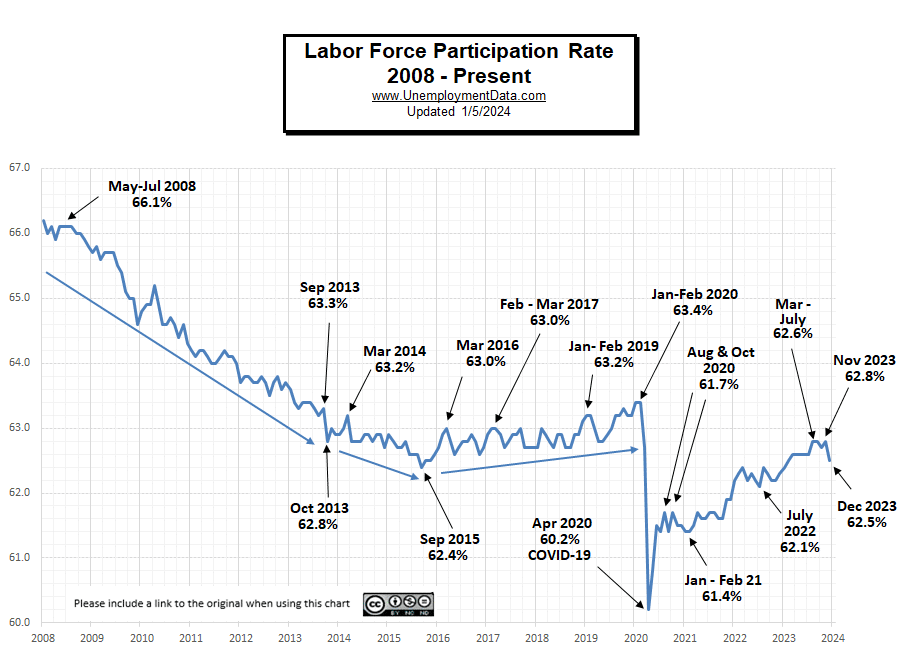
Still Near Full Employment
This chart compares employment levels with the (inverted) unemployment rate.
Full Employment is when everyone who wants a job has one. It is generally considered to be around 3%. After the unemployment rate almost touched the magic full employment line in April, it began moving away (i.e., higher unemployment). But in November it ticked closer again.
Note: The Unemployment rate is inverted to track the employment rate. Neither is Seasonally Adjusted. For more information see Employment vs. Unemployment.
Note: Full employment is not considered to be at zero percent because even when employers are having difficulty finding employees, some people are still unemployed due to either structural unemployment (mismatch between worker skills and job requirements, i.e., not enough training) or simply because they quit their job knowing it would be easy to find another (hopefully better) job. Often referred to as frictional unemployment (there will always be people who have quit or have lost a seasonal job and are in the process of getting a new job).
Seasonally Adjusted U1 through U6 Unemployment Rates
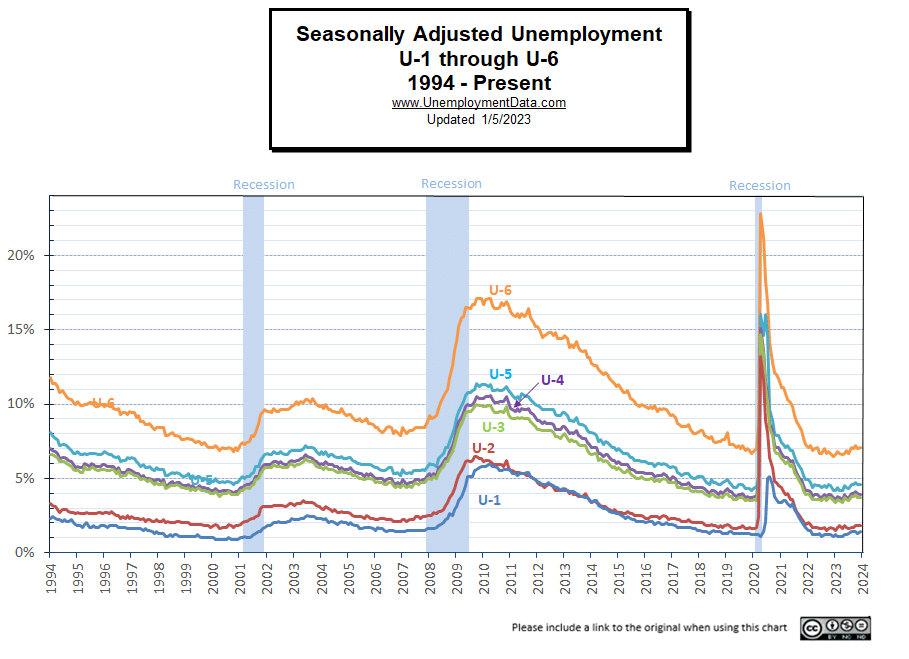
Seasonally Adjusted Unemployment by Education
Despite the other numbers indicating a healthy jobs market, although down slightly this month, unemployment by the less educated has been rising indicating potential weakness.
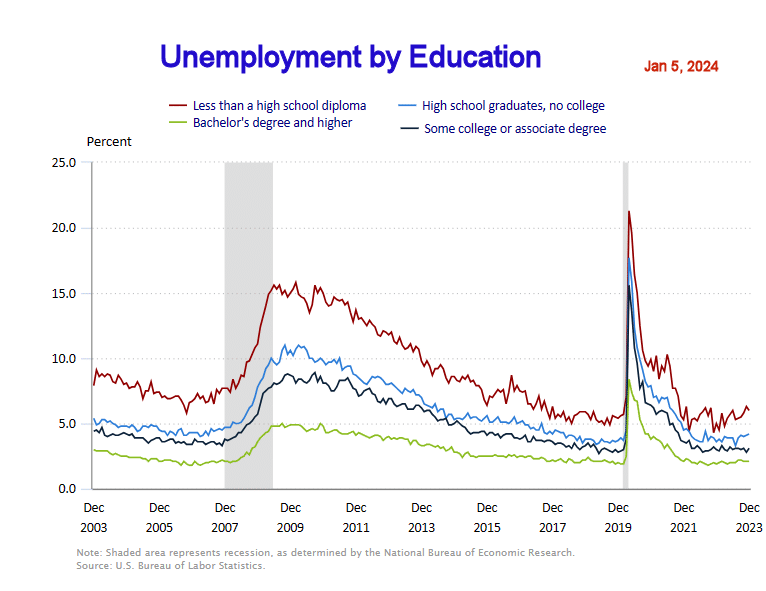
Duration of Unemployment
Although 15-26 week unemployment shows some signs of weakness it hasn’t bled over into 27 weeks and longer yet.
Employment-Population Ratio
The Employment / Population ratio rose from 60.2% of the population employed in October to 60.5% in November, it fell in December to 60.1%.
See Employment Population Ratio for more information.
Read more on UnemploymentData.com.
- Conquer the Skies and Stand Out as an Aviation Medical Examiner
- 10 Job Hazards Everyone Should Watch Out For No Matter Their Industry
- Unemployment by State
- 5 Powerful Ways to Find Your Next Job Online
From InflationData.com
- Not All Prices Have Inflated Since 1964
- Worldwide Inflation by Country in 2023
- November Inflation Mildly Disappoints Stock Market
- Does Inflation Increase Economic Output?
- Inflation Adjusted Mortgage Rates
From Financial Trend Forecaster
- Moore Inflation Predictor
- NYSE ROC
- NASDAQ ROC
- Argentina Mulls Dollarization- What is it?
- The Fed Is Draining Our Economy Like Farmers Have Drained Their Aquifers
- If the Economy Is So Great, Why Are Tax Revenues So Weak?
- Bidenomics: Boom or Bust?
- Could a Hamas vs. Israel War Trigger a Worldwide Recession?
- Mini-Manias: Beware Short-Term Trading Frenzies – Like This One
- Why You Should Expect a Once-in-a-Lifetime Debt Crisis
- Why Do Traders Really Lose Money?
- Quick Takes on Big Financial Trends
- Extremely Rare Market Signal Just Triggered
From OptioMoney.com
- Financial Factors to Consider When Relocating Your Business
- Nomad Living: Managing Finances for a Mobile Lifestyle
- Financial Resilience in Uncertain Times
- Moving Abroad on a Budget
From Your Family Finances

